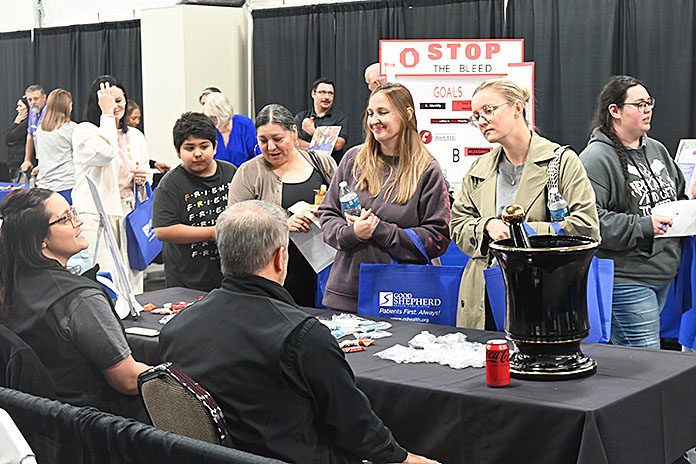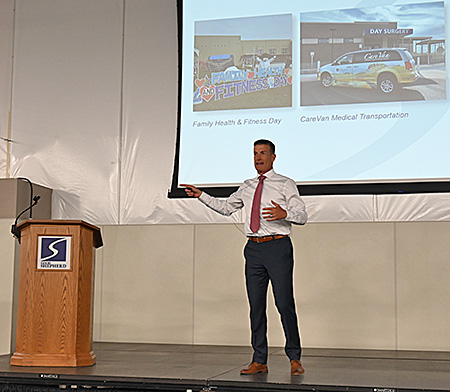
Good Shepherd Health Care System celebrated its highlights and accomplishments of the past year during its seventh annual Community Meeting Wednesday at the Eastern Oregon Trade and Event Center.
Good Shepherd Board of Trustees Chair Jon Lorence welcomed the crowd in his opening remarks with a nod to the 1,250 health care workers employed by Good Shepherd and the services they provide.
“Good Shepherd continues to expand its health care staff to meet the community’s needs,” Lorence said. The Community Meeting, Lorence said, was “a chance to celebrate and appreciate Good Shepherd’s successes in the past year.”
Amanda Carnine, vice president of the Good Shepherd Community Health Foundation, highlighted the foundation’s accomplishments and contributions to the community.
The Festival of Trees, put on by the foundation and Hermiston Kiwanis, raised about $85,000, of which more than $30,000 was allocated to the foundation to invest back into the community.
The annual Scramble for Scholarships raised more than $50,000 in June for medical scholarships.
The foundation has two grant cycles each year – in spring and fall. This past year, 25 grants were given out for a total of $175,625.
“This money will be invested back into our community to enhance the general health and quality of life of our citizens,” Carnine said. This past spring, the foundation awarded $74,500 in medical scholarships to 39 people.
Good Shepherd President and CEO Art Mathisen opened his remarks by acknowledging the work of the Good Shepherd Board of Directors and the foundation’s board.

Mathisen said members of both boards serve “for the love of their community, for the love of the hospital and they give many, many hours of their time to those boards and I just want to publicly thank them for doing that and helping us to have such a good organization for many decades at this point.”
Mathisen said holding community meetings gives Good Shepherd’s leadership and its employees the opportunity to meet and get to know the community.
“We are striving to be the community hospital and health care organization that all of you deserve to have,” Mathisen said.
Mathisen talked about Good Shepherd’s Advisory Board made up of community members and patients. At its most recent meeting, a community member asked Mathisen if Good Shepherd was still considered a hospital since it’s name was changed from Good Shepherd Hospital to Good Shepherd Health Care System nearly a quarter century ago.
“The bottom line is we are still a hospital,” he said. Good Shepherd has the designation of being a Critical Access Hospital serving a rural community. That designation affects how a hospital is reimbursed. A Critical Access Hospital for Medicare patients is reimbursed at about 99 cents to the dollar. Hospitals without the designation are reimbursed by 30 cents to the dollar. Mathisen said having a Critical Access Hospital designation allows hospitals “to keep the doors open and pay their bills and pay their staff.”
Mathisen explained the name change from hospital to health care system.
“What’s a health care system? It’s not just being a hospital,” Mathisen said. The hospital is part of the health care system which includes a medical group, hospice, the health foundation and more. Good Shepherd also offers home health equipment, the CareVan for transporting patients as well as a community health and outreach program.
“Everything we do here makes us a health care system,” he said. Mathisen showed a slide with more than three dozen health care services offered by Good Shepherd ranging from general surgery to sleep medicine to occupational therapy to speech therapy.
Mathisen said the range of services is important because it allows patients to receive the care they need “close to home.”
Mathisen paid tribute to the Executive Team of which he is a member. Excluding Mathisen, who joined Good Shepherd in 2023, the six other members have a combined 73 years of experience serving Good Shepherd.
Mathisen talked about the importance of offering primary care at Good Shepherd. Primary care includes family medicine, general internal medicine, general pediatrics, combined internal medicine/pediatrics (med/peds) and general obstetrics and gynecology. Not all hospitals offer those services.
“I like to have primary care at my hospital, though I haven’t always had primary care at the hospitals I have been at,” Mathisen said. “Primary care is the foundation of a health care organization. If we can provide good primary care, we can keep you from getting sick. We can do a lot of the preventative things. Our vision is to continue growing primary care so you have the access that you need when you need it.”
Mathisen provided an update on Good Shepherd’s Urgent Care clinic. Good Shepherd owns land on Highway 395 and had plans to move Urgent Care to that property. Good Shepherd, however, announced earlier this year that it would remodel the existing Urgent Care on Elm Avenue rather than build a new one on Highway 395.
“It just really didn’t pencil out,” Mathisen said. So, what will become of the land on Highway 395?
“We don’t really have an answer for that,” Mathisen said. “That’s a board decision. We’re kind of waiting to see what the best thing to do with that land will be.”
Good Shepherd extended the Urgent Care hours earlier this year. It is now open from 7 a.m. to 7 p.m. seven days a week. Mathisen said Urgent Care will soon allow online scheduling to minimize a patient’s wait time.
Mathisen also spoke about occupational therapy, a relatively new service offered by Good Shepherd in Hermiston and Boardman.
“We’re supporting our community, supporting our businesses that have a huge OCC MED requirement,” he said.
Mathisen also talked about what being a nonprofit hospital means.
“Being a nonprofit hospital does not mean that no profit is generated,” he said. Mathisen said Good Shepherd uses its profits to fund improvements to patient care, buy new equipment and give back to the community.
In 2024, Good Shepherd provided nearly $8 million in free or reduced services.
“We provide care to everybody regardless of ability to pay,” he said. “And that is really important to all of us here.”
Mathisen said Good Shepherd had 24,909 emergency room visits in the past year.
“For most Critical Access Hospitals, that number is 12,000 to 13,000,” he said. “We’re double that. This is as busy as most hospitals that have 100 beds.”
Another highlight noted by Mathisen was Good Shepherd being named a Best in Class Employer for the second year in a row.
“I was taught that if you take care of your people, they will take care of the mission and they take care of you,” Mathisen said.
Mathisen spoke of some of the latest technology used by Good Shepherd including the Da Vinci Robot that is used in minimally invasive surgeries in the abdominal cavity, including urologic, gynecologic and general surgery procedures.
Good Shepherd’s Mako Robot used by the orthopedics team to perform joint replacement procedures such as knee and hip replacements. Mathisen said there is only one other health care organization in the region that has the Da Vinci and Mako robots.
Mathisen said having the latest technology serves as a “great tool for recruiting great physicians because physicians these days want the top equipment to provide the best surgery for us.”
Wednesday’s Community Meeting featured health booth fair, hors d’oeurves and beverages, more than 30 prize giveaways and a chance to visit with some of the physicians.
For more information about Good Shepherd, visit its website.









